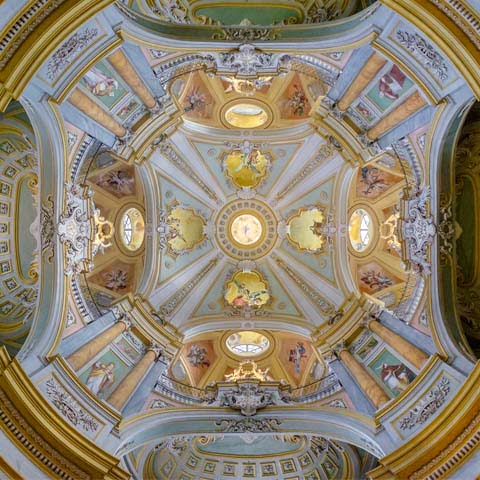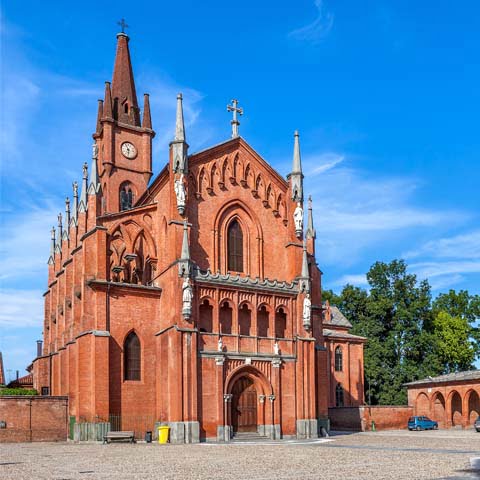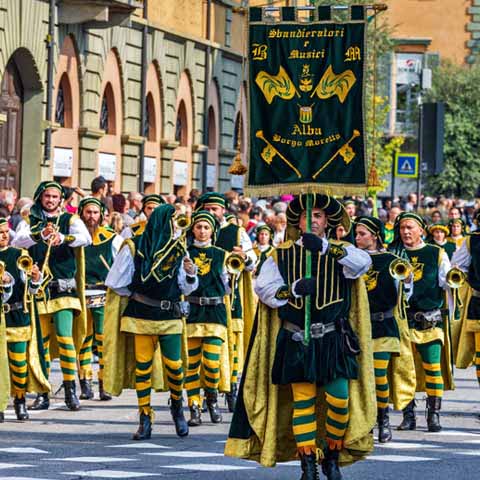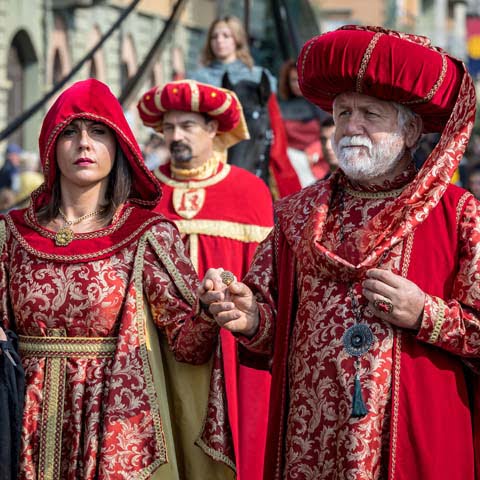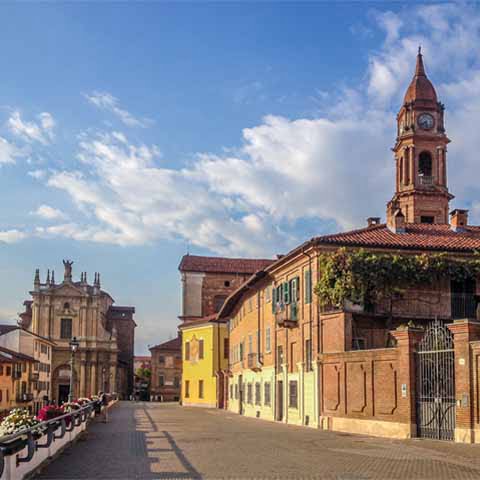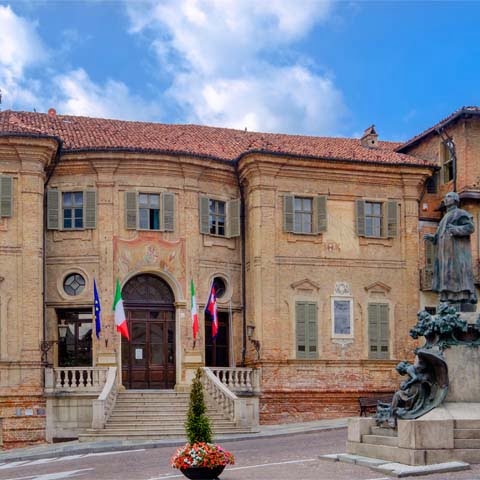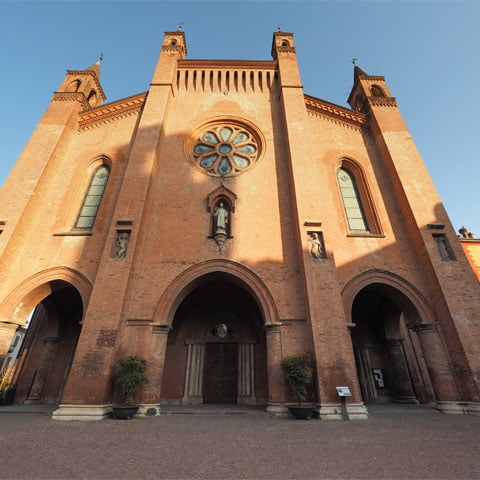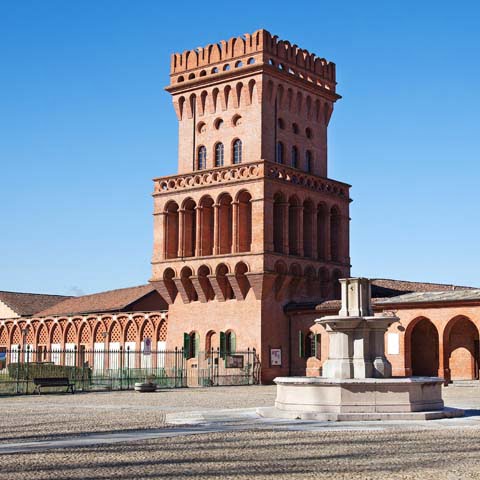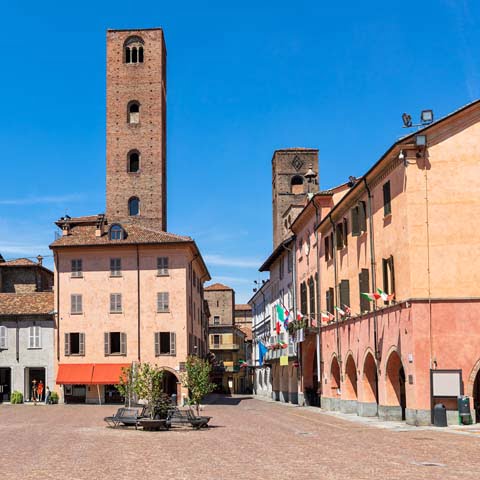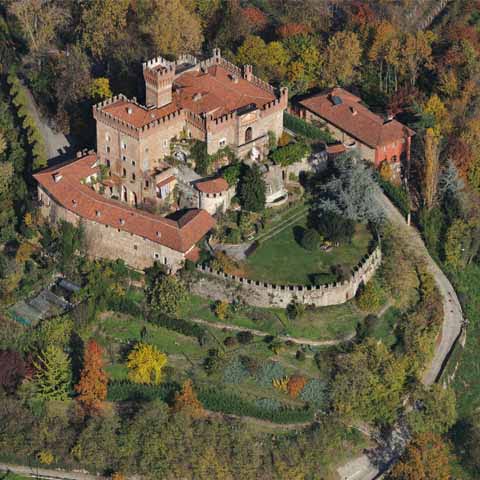Alba is a small town in the hilly area of Langhe, located at the confluence of the Cherasca Stream with the Tanaro River. Alba is renowned as the seat of the National Center for the Studies of Truffles. It is considered the world capital of the sought-after tuber, and in its historic core, Alba preserves a medieval structure.
The city has an almost circular plan, dotted by ancient towers and imposing edifices. The architectural structures, which range in style from a Romanesque-Gothic period to the Baroque époque, bear signs of their illustrious past.
The extraordinary industrial development that boomed in the city over the past decades has not affected the strong link Alba has with its traditions, nor affected its agricultural origins.
In fact, the city is popular throughout the world thanks to its famous white Alba truffle, which plays an important role in the city’s economy. The production of exquisite DOC wines is also important, while the industries of food, confectionery, and clothing sectors fuel the economy.
Alba is also important from a cultural point of view. It is one of the main tourist hubs in Italy, proposing great hikes as well as food and wine tourism. Like many other cities in the country, Alba also has a rich history spanning thousands of years.
PREHISTORY OF ALBA
According to archaeological findings, the territory of Alba has been inhabited since the Neolithic Era, from roughly the sixth millennium BC onwards. It is believed that the first populations were involved in hunting and agriculture and settled their huts in villages grouped in the area of Borgo Piave and on the left bank of the Cherasca Stream, near the confluence with the Tanaro River.
Multiple artifacts including rudimentary tools and pottery attest to the early cultures in the area.
In the following millennia, the territory was occupied by the Liguri Stazielli, an ethnic group of Celtic origins which invaded the area towards the end of the fifth century BC.
It is also believed that it was the Ligurians who gave Alba its name, which in their language would mean the “white city.”
Under Roman occupation, the city received the name of Alba Pompeia, and due to its strategic importance on the Roman consular routes, it soon received the title of municipium. The city was included in the Regio IX Liguria together with other settlements in the region, including Asti.
Various Roman findings scattered throughout the region show that in the first two centuries of Roman domination, Alba evolved together with nearby Pollenzo and Bene Vagienna, forming a strategic triangle based on trade relationships. These commercial interests led to the creation of considerably interesting urban structures, including an aqueduct and a sewer system.
The Roman Alba enjoyed an autonomous administration and had its own judiciary system. The people were grouped into six orders: the decurions, the wealthiest citizens, the Augustals, the knights, the contractors, and the freedmen.
Besides these orders, there were also the plebians, divided into colleges based on arts and trades. Many of the people in the area were involved in blacksmithing, the manufacture of wool and fabric, as well as lumbermen responsible for supplying timber for houses and ships.
Agriculture and breeding were other important activities in Alba Pompeia, and the historians even describe the existence of a unique agricultural technique applied since the earliest ages to a refined and evolved viniculture.
During the Roman age, Alba received many of the most important Roman buildings, including the imposing polygonal city walls.
HISTORY OF ALBA
In the period following the Roman domination, the city received its medieval walls. The first were built by the Gothic-Lombard populations, then followed by the post-Carolingians and then finally by the Hungarian-Saracen invaders. However, none of these populations changed the original Roman perimeter, which remained untouched until modern times.
After the fall of the Western Roman Empire, the city was subjected to Barbarian invasions. It was then occupied by the Burgundians, followed in 640 by the Lombards and then by Charlemagne. All of these changes created the right conditions for the development of feudalism.
The subsequent incursions of the Saracens brought poverty to the diocese of Alba, weakening it to such an extent that it was merged with the dioceses of Asti and Savona.
Nevertheless, the medieval city walls represented a remarkable defense system and allowed the people here to thrive. In the eleventh century, Alba was designated as a free commune and joined the Lombard League.
What followed was a true territorial expansion of the municipality during which Alba saw the formation of seven Camparie and six castles with purely defensive functions, all built on the adjacent hills in the shape of a crown around the city. This is also when many of the cities famed towers were built, earning Alba the nickname, “the city of a hundred towers.”
During the same period, the city also witnessed the rise of monasteries, churches, and six hospitals, including the Hospital of San Lazzaro, which was built for the treatment of lepers and those with other infectious diseases.
In 1259, Alba allied with Charles I of Anjou in an attempt to manage disputes with neighboring Asti, but the rivalry and failed promises among the Guelph and Ghibelline factions had the opposite effect. Asti turned into the undeniable enemy of Alba and became interested in dominance over the territory and in depriving the city of its dominion over the Tanaro Valley.
In the years that followed, Alba lost its free commune status and changed hands from nearby Montferrat to the Visconti of Milan and others.
In the first half of the sixteenth century, the conflict between the French and Spanish involved Alba directly and transformed it into the scene of numerous bloody conflicts. The situation took a turn for the worse with the arrival of Charles V, and the history and chronicles of those years record dozens of clashes between rival armies.
The consequences of these clashes had a major impact on monuments and works of art, which were subject to devastation and looting.
After the Peace of Cateau-Cambrésis in 1559, Alba was given to the Gonzaga of Mantua. Under their rule, the city witnessed a period of relative peace, although the people found it hard to accept the devastation and impoverishment of the territory.
As if the damage caused by the wars was not enough, the territory was also struck by earthquakes, which weakened the position of the city even more.
Following the death of Francesco IV Gonzaga, Alba once again became a target of other powers and was attacked by the Savoy, who laid it under siege at the beginning of the seventeenth century, then managed to conquer it on April 1, 1628, after alternating clashes and skirmishes with the Gonzaga.
Once the military operations ceased, the city became subject to the plague of 1630 that ravaged parts of northern and central Italy. The first symptoms began to appear in 1630 and led to a demographic decline over a short period.
Nevertheless, after the plague, Alba flourished once more with a revival of fairs, festivals, and markets that had been suspended for decades. Recovery was favored, but unfortunately, it did not last long due to the interminable dynastic wars of the time.
Thankfully though, the eighteenth century brought some cultural enlightenment that saw the flourishing of literary and artistic activities. Among the most important was the creation of the Philharmonic and Literary Academy, which attracted illustrious figures such as Silvio Pellico and Giovanni Prati.
The development of the city also involved the construction of new buildings, as well as the restoration of old ones, including the San Lazzaro Hospital, the Church of Santi Cosma e Damiano, and the Church of Santa Maria Maddalena.
At the end of the eighteenth century, Alba, together with other cities in the region, became acquainted with the ideas of the French Revolution. Following Jacobin ideals, Alba proclaimed itself a republic and accepted the entry of Napoleon Bonaparte on April 28, 1796.
However, the French adventure was short-lived and marked by destruction. During this time, many works of art were stolen from Alba and historic buildings were defiled, such as the Church of San Domenico, which was converted into a stable.
Following these events, the city was asked to contribute to French military expenses. These contributions, together with the looting of artworks and acts of violence against the population exasperated the people.
Furthermore, the introduction of compulsory military service for all young men above the age of nineteen, and their obligation to be enrolled in the Napoleonic Army, led many citizens of Alba to leave the city and join the formations of insurgents, the so-called barbets, in an attempt to counter the abuses committed by the French army.
The reconstruction of the city following the devastation of the French Revolution was initiated by Charles Felix of Sardinia, Duke of Savoy, who began the construction of the Monastery of Maddalena and helped the reorganization of the road system that connected Alba with Savona.
The urban planner and architect Giorgio Busca was involved in this project and contributed to the realization of numerous buildings, including the Teatro Sociale, Piazza Savona, Palazzo Miroglio, and the reconstruction of Via Roma.
The beginning of the nineteenth century saw the emergence of a rising bourgeoisie and adjacent classes including traders, technicians, and professionals who gradually became involved in public offices. This movement gave impetus to numerous forms of Società di Mutuo Soccorso (Mutual Aid Societies), including one that brought the artists and workers together.
The twentieth century came with new struggles, and after World War I, Alba, along with the rest of Italy, saw the emergence of Fascism. During this time, Alba undertook successful trade activities, and in 1929 the famous Truffle Fair began.
During World War II, the city was proclaimed an independent republic after being captured and run by the partisans for 23 days. Due to its important role in the events, the city even obtained a gold medal for its military value and intense partisan activity.
Throughout the course of the war, Carlo Ravera, the marshal of Alba’s carabinieri, saved many Jewish families from deportation, and instead of proceeding with their arrest, helped them escape.
After the war, the city endured violent floods in 1948 and 1994 caused by the Tanaro River, which devastated some areas of the city. Despite these negative events, Alba managed to thrive in the sectors of viniculture and agriculture.
Thanks to the natural treasure Alba is known for, the truffles, the city became an important destination for all food lovers. Today, Alba is renowned for its wines and gastronomy and focuses its economy mainly on the food, beverage, and tourism sectors. In 2017, Alba was even recognized by UNESCO as a Creative City of Gastronomy.
ARCHEOLOGY OF ALBA
Alba has an ancient history, and vestiges of the various civilizations are scattered throughout the city. Most evidence includes remains from the Roman Empire, and an exciting place to visit is Underground Alba, which reveals the remains hidden under the modern city.
Situated in one of Alba’s parks, the Garden of Experimental Archaeology houses the reconstruction of Neolithic huts and consists of a hypothetical life-size reproduction of what life was believed to be like in the era, based on stratigraphic findings.
Historical materials from the pre-Roman and Roman eras are preserved in the Federico Eusebio Civic Museum of Archeology and Natural Sciences, which is one of the most important museums in Alba. Epigraphic and archaeological material retrieved from Alba Pompeia can be seen here. Many of the artifacts in the museum describe the life of the mid-high Roman classes and provide evidence of the Celtic-Ligurian origins of the city.
Don't just see Italy, live it.
Your dream trip to Italy has never been closer
No more endlessly scrolling travel sites. Our travel experts will craft the perfect, one-of-a-kind trip just for you.

300+
DESTINATIONS
We offer more Italian destinations than any travel site. Do and see more with Trips 2 Italy.
1 (of a kind)
ITINERARIES
Because your dream trip to Italy should be designed for you, not for the masses.
100%
PEACE OF MIND
From flights and accommodations, to food and activities - we take care of every detail.
